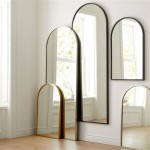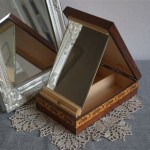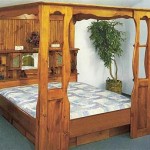Wall Mounting Hardware for Mirrors
Selecting appropriate hardware for mounting a mirror is crucial for both safety and aesthetics. A poorly chosen mounting system can lead to instability, potentially causing the mirror to fall and break. This article will explore the various types of mirror mounting hardware available, factors to consider when choosing hardware, and best practices for installation.
Mirror mounting hardware generally falls into a few key categories: J-clips, D-rings, French cleats, and adhesive mounts. Each type offers specific advantages and disadvantages depending on the mirror's size, weight, and desired aesthetic.
J-clips, also known as Z-clips, consist of two interlocking metal pieces. One piece attaches to the back of the mirror, while the other mounts to the wall. The mirror then slides into the wall-mounted clip, securing it in place. J-clips provide a relatively low-profile mounting solution, ideal for mirrors that sit flush against the wall. However, they may not be suitable for very heavy or large mirrors.
D-rings are metal rings attached to the back of the mirror. Corresponding screws or hooks are installed on the wall, and the D-rings hang from these anchors. This method allows for some adjustability during installation and can accommodate heavier mirrors than J-clips. However, D-rings may be visible above the top edge of the mirror, which can affect the overall aesthetic.
French cleats offer a robust and secure mounting solution for heavier and oversized mirrors. A French cleat consists of two interlocking pieces of wood or metal, each with a 45-degree angled edge. One piece attaches to the wall, and the other to the back of the mirror. The angled edges interlock, creating a strong and stable connection. French cleats are often hidden from view, providing a clean, seamless look.
Adhesive mounts utilize strong adhesive to bond the mirror directly to the wall. This method eliminates the need for drilling holes and offers a simple installation process. However, adhesive mounts are generally only suitable for smaller, lighter mirrors and may not be suitable for all wall surfaces. Careful consideration should be given to the manufacturer's weight limitations and compatibility with the specific wall material.
Selecting the correct hardware requires careful evaluation of several factors. The weight of the mirror is paramount. Heavier mirrors necessitate stronger hardware like French cleats or heavy-duty D-rings. Attempting to mount a heavy mirror with inadequate hardware significantly increases the risk of failure.
The size of the mirror also influences hardware choice. Larger mirrors, even if relatively lightweight, benefit from more robust mounting systems to distribute the weight evenly. Small mirrors can often be securely mounted with J-clips or adhesive mounts, provided they are within the weight limitations of the chosen hardware.
Wall material plays a critical role in hardware selection and installation. Different wall materials require different types of anchors. Drywall requires specialized anchors like toggle bolts or molly bolts to provide adequate support. Solid wood walls can typically accommodate screws directly, while concrete or brick walls require masonry anchors and pre-drilled holes.
The desired aesthetic also influences hardware choices. For a minimalist look, hidden hardware like French cleats or adhesive mounts are preferred. If a more traditional or decorative appearance is desired, visible D-rings or decorative J-clips can complement the mirror's design.
Prior to installation, carefully measure the mirror and mark the desired location on the wall. Use a level to ensure the markings are perfectly horizontal. When drilling holes, ensure the drill bit size corresponds to the anchor being used. Following the manufacturer's instructions for the specific hardware is crucial for a secure and successful installation.
For heavier mirrors, it is often advisable to use multiple mounting points to distribute the weight evenly. This reduces stress on individual anchors and enhances stability. Consider using a stud finder to locate wall studs for optimal anchoring strength. If studs are not available, use appropriate anchors for the specific wall material.
Safety should always be a primary concern during installation. Wear appropriate safety glasses when drilling to protect eyes from debris. Use caution when handling heavy mirrors and consider enlisting assistance if necessary. Ensure the chosen hardware is rated for the weight of the mirror, and never exceed the manufacturer's recommended weight limits.
Proper installation of mirror mounting hardware is essential for ensuring both the safety and longevity of the mirror. By carefully considering the factors discussed above and following best practices, individuals can confidently and securely mount mirrors of varying sizes and weights.

Simple Mount 30 In Heavy Duty Mirror And Picture Hanger Hm 30d The Home Depot

Mirror Clamp Support Wall Mounted Glass Bracket Heavy Duty

How I Installed A Really Big Mirror Merrypad Diy Network

Heavy Picture Mirror Hanging Kit 50 Kg

Invisible Mirror Clip Onward Hardware

4 Mirror Wall Hanging Mounting Fixing Kit Frameless Plastic Clips

4 Mirror Wall Hanging Mounting Fixing Kit Frameless Plastic Clips

Clips Mirrors Mirror Accessories At Com

Ook 20 Lb 1 2 In Steel Mirror Support Hangers Pack 50233 The Home Depot

Mirror Clamp Support Wall Mounted Glass Bracket Heavy Duty








